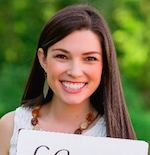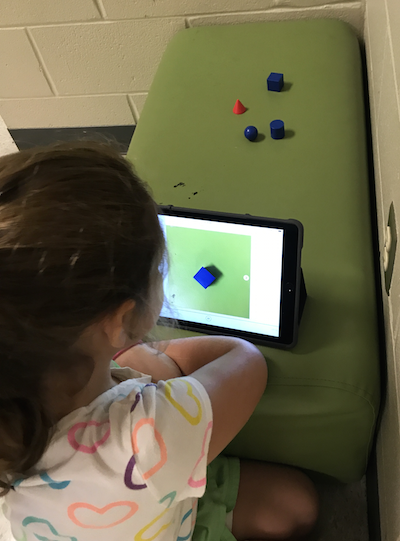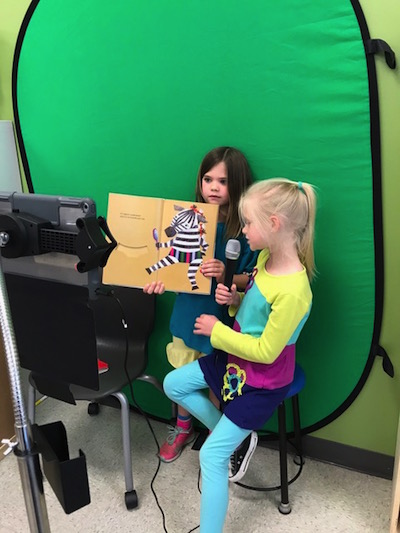By Lauren Davis, Frances Granger, and Beth Sanders
On any given day as you walk down the hallways of Pike Road Elementary School you might see first graders prompting and recording each other as they create video reflections of their learning — or second graders taking photos of their latest creation and doing voice-over recordings describing what they now know.

If you were walking with us on a recent day, you would have met six kindergarten students sharing what being a good digital citizen means to them as they taught sixth graders how to post a positive video about their learning on the Seesaw learning platform (and then take it back to their classrooms and homes to teach others).

The world is changing, the way our children are learning is changing, the tools at our students’ grasp are constantly improving, but our job as educators will always be the same — to empower every student to become the best version of themselves: proud, passionate, and prepared to enter the next stage of their life carrying all that they’ve learned with them — ready to thrive and make a positive impact on their world.
A student-driven digital portfolio is one piece of this puzzle and at Pike Road Elementary School, with the help of the Seesaw platform, portfolios are making a huge impact — empowering our learners to prove they are capable of much more than what traditional schooling has defined as “evidence of learning.”
Some perspective
Current kindergarten students will be graduating high school in 2035, college in roughly 2039, and joining the workforce in 2040. We’ll give you a second to wrap your head around that.

Most of us who have worked in schools know that while the world is changing faster than we can blink, public education in America has stayed roughly the same since the Industrial Revolution of the early 1900s. And yet, according to the latest research published by the World Economic Forum, soon we, and our students, will only be as good as the contemporary skills we possess.
But which skills are they? How can we make sure we equip our students to keep pace? How will teachers and parents ensure they are equipping the adult workforce of 2040 for the world they will be entering and leading?
Harvard’s David Deming says the challenge now is for educators to complement their teaching of technical skills like mathematics and computer science with a focus on making sure the citizens of the future have the “soft skills” to compete in the new jobs market and thrive in the new society. And he has good news: a portion of these skills are already found in Pre-K classrooms – things like sharing, empathy, and cooperation.
Another thought leader, digital marketing guru Seth Godin, believes we should begin referring to “soft skills” as “real skills.” In a much-discussed 2017 article, Godin identifies five essential “real skills” without which, he argues, workers and leaders in every sector will falter, no matter how strong their technical/vocational skills might be.
The five? Self control. Productivity. Wisdom. Perception. Influence.
Educators need to be full participants in this conversation about the complete skill set adults will need in the decades to come. Across Alabama and the nation, our Pre-K and elementary grades are already teaching the graduating classes of 2029-2034, and we want to be sure we are equipping them with all the critical skills necessary for happy and productive lives.

Our portfolio-driven approach
At Pike Road Elementary School, our K-4 lead learners (that’s what we call our teachers) are reimagining assessment by empowering the children in their classrooms to master the soft/real skills they need while these young learners are co-leading and sharing their learning through the use of Seesaw, a student driven digital portfolio.
Why digital portfolios? In a learner-centered, standards-based culture it’s essential that the students themselves are helping lead their own learning by curating high quality examples of their progress both in application and action. Digital portfolios are a powerful way to do that.
The digital portfolio also becomes a space to “reflect as we go” and share creative learning tied to developing dispositions and skills that reach far beyond the content standards. Digital portfolios provide a place for students to get excited about showing their learning, expressing themselves, and creating a a body of work they are proud to be sharing.

A look inside a 2nd grade classroom
At this point, we’d like to turn this story over to our co-author Lauren Davis, a 2nd grade teacher at Pike Road, who shares her perspective on skills development and Seesaw – straight from her classroom.
On the first day of school, 22 second graders filed into my classroom. There were some who’d just finished learning their letter sounds and others who were doing their best to understand basic math number sense. More than half were reading below grade level and some were already showing signs of a fixed mindset and “give-up” attitude.
How I desperately wished they could realize right then what they would end up being able to do by the end of the year (not just with math and reading but also with lifelong skills such as communication, creativity, responsibility, collaboration) — and the role they would play during the school year in showing their learning journey in my class.
Beginning the second week of school, I introduced a new learning tool to my students that would empower them to show their learning and practice multiple skills. I told them all about Seesaw, our digital learning portfolio tool.
I had spent the previous summer digging deep into this platform and even did the intensive online training to become a Seesaw Ambassador. I knew that learning how to successfully use this platform might be asking a lot of the children, but I also knew they were more than capable of mastering the task and gaining the endless benefits of its use.
I also realized that introducing this so early in the year might present its own difficulties, but what I’ve found is that each time I’ve raised the bar for my students, each time I’ve asked them to take a little bit more responsibility for their learning, they’ve done it and then some, pushing us all toward deeper understanding.
At our school, we believe that children are fully capable of being leaders of their own learning with their teachers as partners in the process. Our students work together at the beginning of the school year to develop our classroom norms known as the “Patriot Promises.” One of these promises is “contribution,” where our kids understand it is their goal to always contribute their best effort and their best self to their work at school. They also understand the larger goal is to be able to contribute in the world and to their futures far beyond my classroom.
Another promise is “commitment.” When our students commit, they agree to embed quality in everything they do. We believe this should be both a part of our learners’ behavior expectations and their digital expectations.

Wow Work and What Now Work
If you’re considering using Seesaw with your students one of the first things I suggest is getting your students thinking about what “wow work” and “what now” work are and how to guide your students through the process of reflecting on what they create and are preparing to share.
Wow Work is considered a student’s best work. It could be something they’ve learned for the first time or something they’ve developed through mastering several standards and growing multiple soft skills. It is a 2018-worthy type of summative assessment. What Now Work is work that is completed through formative assessments during the learning process. It can be a step along the way to Wow Work or it can be evidence of a stand alone formative assessment. It includes a variety of examples of what learners are doing right now on their journey to fully mastering a standard. (See Pike Road Elementary’s Standards-Based Assessment Handbook)

The more ownership students have of their portfolio, the more it increases the likelihood that the learning is retained, that they will be encouraged to reflect, and the more likely they will want to share their entries with others.
When we raise the bar for our expectations of their portfolios, we are showing the students what quality looks like. We talk about how our posts represent ourselves to the outside world and we should want to put our best foot forward. We also want our parents, peers and audience to get value from seeing our work as high quality and unique examples of deep understanding of and application of learning.
To be able to accomplish these things and make them a constant of your classroom culture, time and effort needs to be invested on the front end of launching a digital portfolio. At our school, we tell one another, “We need to slow down so that we can eventually go fast.”
I began with a couple goals, and as my learners mastered the first (being able to login and post a photo, for example), we would move onto our next goal (creating quality recordings). During the process, we talk about what makes a good and bad photo post and video recording. This seems to be the hardest for my second graders to master, but once they’ve got it, their skills and ideas for how to create video recordings continue to improve.
We have specific roles, we practice and give each other friendly feedback, and we commit to getting better together. By starting off with all our Seesaw sharing centered around the students’ own interests, it’s easier to shift towards sharing their wow work as it relates to skills and standards mastery.
Examples from Lauren’s C2 student portfolios:
Photos:
Recordings:
Videos:

Portfolios in First Grade
Now, we’d like to turn this story over to our next co-author, Frances Granger, a 1st grade teacher at Pike Road, who will share some of the why behind using Seesaw and the impact it makes on student ownership of learning.
Seesaw makes it easier for students to share their learning with their peers, their parents, and globally to an authentic audience, connecting far beyond the four walls of their classroom.
After my C1 learners visited the fire department and they reflected on what they learned on the Seesaw platform, we then emailed our posts to the firefighters we’d met and learned from earlier that same day, and the same evening those firefighters gave us feedback on our posts! Another example: when my students studied light and shadow, they combined photos and audio comments into this group post, shareable with many kinds of audiences.
At PRES our learners as young as age six are able to actively choose their best work, sharing their learning verbally and visually in a number of creative ways, and practicing digital citizenship by giving feedback to each other using the THINK acronym. As they leave feedback to each other they consider these questions:
Is it Thoughtful?
Is it Helpful?
Is it Inspiring?
Is it Nice?
Is it Kind?
Viewing and critiquing each other’s work has lead to new ideas and empowerment while also creating positive and active digital citizens who are able to give and receive thoughtful feedback – in first grade!
In class we talk together about what it means to think before we post. In the “internet troll” and negative comment culture we have in social media spaces today, can you imagine if every adult in our society had practiced giving feedback with the THINK acronym in mind before they posted on Facebook, Twitter, online news stories, etc?!

Our first graders’ learning has become meaningful, purposeful, and much more than just “showing what they know” related to content — and they look forward to sharing it with others and receiving feedback from their teacher, peers, parents, and authentic audience members.
I can only imagine where these learners will be by the time they go to high school, college, and enter the world as young adults if they continue on a learning journey like this. Yet I am confident they will be more prepared and have a long list of skills that will truly be useful in the future society they will be adults in.
Our main goal with Seesaw is empowering our students to take ownership of their journals. In order to create ownership, students need to feel like they are in charge of what they are putting on their portfolio. The more ownership of the learning you hand over to students, the more engagement you’re going to have. As teachers, we have to make sure that the portfolios (and the learning) matter to the students.
Students need to believe that the work they are doing and sharing digitally makes a difference beyond their classroom and is important to share far beyond just the teacher. A lot of the motivation children have to continue sharing and creating on their portfolios directly relates back to the feedback they are getting from the teacher, their peers, their parents, and beyond.
Testimony from C1 parents and Learners:
“I absolutely love the Seesaw app! I get to see exactly what my child is learning at school throughout her day. When she gets home she is excited to talk with me about the videos and assignments she has posted, which leads to further discussion of her learning skills and standards. This app helps us connect through her school work and makes us as parents better partners with her teacher as we are more able to reinforce learning at home.” – Shelby Rowe, mother of Mrs. Granger’s C1 learner Addie. (Addie shares her learning about the parts of a seed)
“Seesaw is great because you can add stuff from different Apps. Your parents can see your work and comment on it.” – Nathaniel, C1 learner in Mrs. Granger’s class (Nathaniel shares a published book using the Shadow Puppet App)
“It’s a place where when I create something I can put it and I can go back to it and check out the memory and you can look at other people’s stuff and make comments on what they created.”
– Micaiah, C1 learner in Mrs. Granger’s class (Micaiah and friends share an original play they co-authored)
Visit My Little (Digital) Journal for more inspiration on how to use digital portfolios in your classroom.

Seesaw is a game-changer, if we let it be
According to assessment expert Evangeline Harris Stefanakis (2002), “The word assess comes from the Latin assidere, which means to sit beside. Literally then, to assess means to sit beside the learner.” The power of the Seesaw digital portfolio platform is that it figuratively and literally allows us to sit beside our students as they practice skills, apply knowledge and drive the sharing of their learning.
Assessment shifts from something being done to students to something being done with students. We get to see their thinking, help them identify, create, and share their best work. They can achieve a level of reflection on their learning unimaginable before platforms like Seesaw existed.
Not only can we see the growth of our learners in real time, they are also inviting their peers, parents, and the world to experience their learning journey too. Seesaw is the tool, and it is a game-changer, but the tool means nothing without the mindset that our youngest students are fully capable of practicing and mastering relevant real-world skills, making choices about how to share what they’ve learned, and feeling fully empowered to use the tools they have access to safely and freely.
Frances Granger teaches first grade at Pike Road Elementary. She grew up in Auburn and earned her Bachelor’s Degree in Early Childhood Education from Auburn Univerity. After teaching kindergarten for three years in Washington D.C., Frances returned to Alabama to teach.
Lauren Davis taught second grade at Pike Road Elementary and is a certified Seesaw Ambassador. This year she’s packed up what she’s learned to teach abroad at an American school in Dubai.
Beth Sanders is Coordinator of Technology Integration for Pike Road Schools in Montgomery, Alabama. Previously, she served as Director of Innovation for Enterprise City Schools and a technology Integration specialist and social studies teacher for Tarrant City Schools. Beth is an Apple Distinguished Educator , Google Certified Educator, and Buck Institute project-based learning trained teacher.
Want to stay connected to Pike Road Elementary School and Beth, Frances, and Lauren? Following their school hashtag: #PikeRoadWay and connect with them on Twitter: @mssandersedu, @Mrs_G123, and @MrsLDavis1.

0 Comments on "Pike Road Portfolios: Empowering Primary Kids to Lead Their Own Learning"